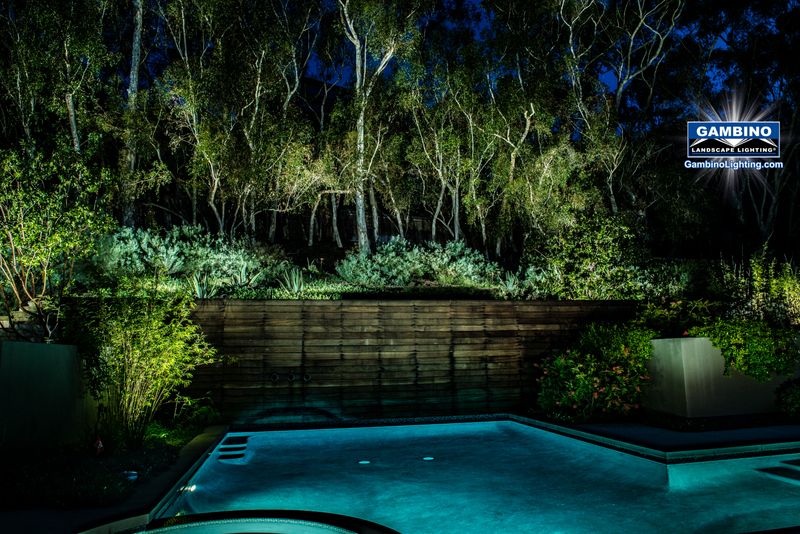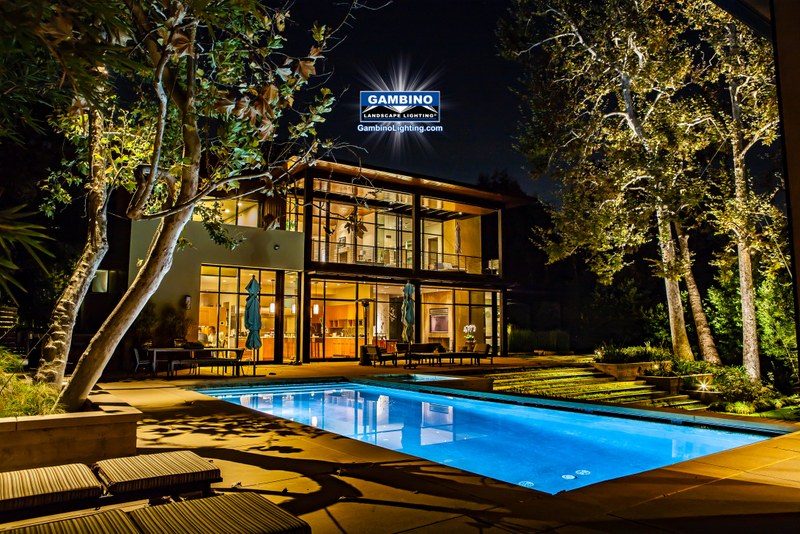30 Mar Common LED Landscape Lighting mistakes made by some Designers/Builders
By Mike Gambino
Don’t get misled by a disreputable LED landscape lighting Designer/Builder and end up with an installation that doesn’t work for you. Avoid the 10 common mistakes in LED Landscape lighting.
THINKING OF having an LED landscape Lighting system designed and installed for your property? Don’t do anything until you’ve checked out the 10 mistakes that most designer/builders make with LED landscape lighting.
 1- High Contrast lighting due to poor distribution and spread of light
1- High Contrast lighting due to poor distribution and spread of light
Probably THE most common issue with landscape lighting. LED landscape light fixtures have relatively narrow light distribution patterns due to their need for glare control and have long shrouds and recessed lamps (look at problem #10 to see the result of fixtures that do not effectively shield the light source) which tend to have more directional and limited distribution spreads. The way to counterbalance this is to place light sources further from their subjects. This is often not possible, feasible or result in desirable effect. The other way to mitigate this is to use more fixtures set at lower wattages for better coverage and optimum effect.
So, for instance, if one or two up lighting fixtures are used on a large tree when 4 or 5 are actually needed, you’ll get much less efficient and effective distribution of light. This additional light is actually useful, without it you can end up with spotty and hot lighting on the tree with large areas of darkness causing high contrast that is not attractive or flattering to the tree. Sufficient fixture quantities are often sacrificed to keep lower costs and win bids however the end result of the project suffers most every time.
2- They have spaces which are too bright and unlighted areas not Bright enough
Because most design builders do not use enough fixtures and because the LED light is mostly directional as described above, you’ll probably get much more or what appears to be more intense light from each fixture. To compensate for not having enough fixtures often designers will use higher brightness LED’s inappropriate for their subjects. Because these areas are overly bright they make areas with no light appear darker.
3 They use LED’s which are too ‘cold’
The cool or warm appearance of lights is measured in Kelvin. Incandescent lamps are 2700K while halogen is 3200K. If you use LEDs which are 5000K your spaces will look distinctly bluish green in color. Most LED’s are sourced from Asia and tend to be cool, because that’s their cultural preference and it’s easier to make a more efficient LED light in cool color temperatures. Insist warm color LED lamps consistent with the color of higher quality halogen lamps of days passed are used.
 4- They use LED’s which make colors look dull
4- They use LED’s which make colors look dull
The ability of a light to render colors is measured in the color rendering index, or CRI. As a general rule you want lights with a CRI of 80, or better still, 90. One particular area of weakness with LED lights is the R9 (red) value, as this isn’t included in the CRI measurement. Make sure that’s over 80 too or else colors will look muddy and dull instead of vibrant and color correct.
5- They install systems with no regard to voltage
Savvy seasoned and experienced landscape lighting designer builders do not listen to marketing propaganda of suppliers that state LED lamps can operate from 8-24 volts. Truth be told is that LED lights are engineered to operate at peak performance and longevity at 12 volts. Some LED’s do not dim smoothly at all and in fact, at low power levels they will often flicker and flash leading to premature component failure.
6 -They buy LED’s from a dubious supplier
A whole slew of new LED landscape lighting designer builders have entered the market over the last few years. It’s worth doing due diligence before hiring them. Are they a reputable brand? Are they using LED’s from a reputable US manufacturer such as CREE? How long have they been around? Do they buy their products from a reputable supplier? Do they have successful projects and verifiable references in your area?
 7- They don’t offer a decent warranty
7- They don’t offer a decent warranty
Will the designer/builder give you a warranty? Will they be around to honor that warranty? Is the guarantee for longer than the designer/builder has been in business? Check out the small print. Sometimes there are limits on burning hours and sometimes you have to register separately online within 90 days to ‘activate’ your warranty and jump through hoops.
8 They use LED’s that won’t last
The generally-agreed rated life of an LED is the point at which its light output has dropped to 70 per cent of the initial output, termed L70. For example, you might see a rated life of 50,000 hours to L70. Again, optimistic ratings abound on the sales literature. And there is the phenomenon of ‘early failures’ – LED’s that fail not long after installation.
 9 They don’t ‘future proof’ the installation
9 They don’t ‘future proof’ the installation
Say one of your LED’s fails in 18 months time. You phone up your designer/builder to get a replacement, and he or she says: ‘They’re not manufacturing that model anymore – we can supply our latest model’. Be warned, the latest model could look very different from what’s in your lighting fixture. Worse, you can’t get hold of the company, because it no longer exists.
10 They use placements or fixtures with too much glare
With any form of light, the problem of glare is always there, especially with fixtures not well designed to conceal the LED light source. Often LED fixtures deliver all their light at the surface of the fixture glass lens. If the glass lens is visible and not effectively shielded by baffles, shrouds or other natural elements in the landscape such as boulders, shrubs, low walls, etc. then objectionable glare will be present.
 This landscape lighting blog is published by Mike Gambino of Gambino landscape lighting inc. all
This landscape lighting blog is published by Mike Gambino of Gambino landscape lighting inc. all rights reserved. Mike is a professional landscape lighting system designer/ builder and has been designing, installing and maintaining landscape lighting systems for more than 28 years. Mike resides in the Los Angeles area with his wife and 2 sons. To visit his website go to www.Gambinolighting.com . To inquire about hiring Mike please click here .
rights reserved. Mike is a professional landscape lighting system designer/ builder and has been designing, installing and maintaining landscape lighting systems for more than 28 years. Mike resides in the Los Angeles area with his wife and 2 sons. To visit his website go to www.Gambinolighting.com . To inquire about hiring Mike please click here .
Blog articles may be published with permission on other websites without editing or removing links.



No Comments